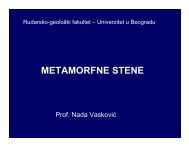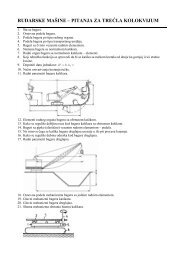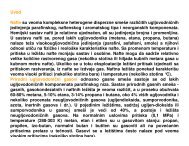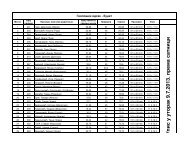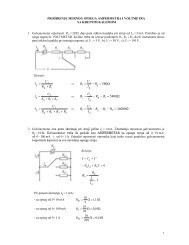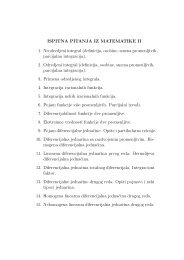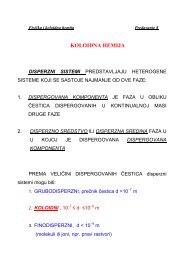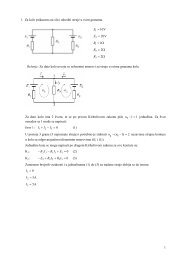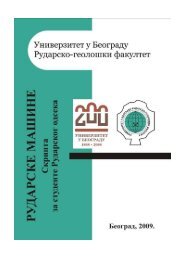KÑига LXXII
KÑига LXXII
KÑига LXXII
Create successful ePaper yourself
Turn your PDF publications into a flip-book with our unique Google optimized e-Paper software.
106<br />
IVAN ANTONIJEVIĆ<br />
Ore-clasts of Metovnica–Nikoličevo<br />
Massive copper sulphide ore-clasts of Metovnica,<br />
south of Bor and Novo Okno, were recognized and<br />
investigated before the Novo Okno deposit was uncovered.<br />
These ore-clasts were found in association<br />
with fresh epiclastic breccia of hornblende-biotite<br />
andesite and Timok andesite and subvolcanic rocks of<br />
the Borska River.<br />
Large chaotic accumulations of ore-clastic rocks<br />
near Metovnica were identified as hydrothermal ore<br />
occurrences on the banks of the Brestovačka and Suva<br />
Rivers. The presence of hydrothermally altered rock<br />
fragments and matrix was notable. The rock fragments<br />
varied in size from a few to 25 cm and were<br />
angular, coated by malachite or azurite, but including<br />
no olistolith habit.<br />
Pyritized rocks with chalcopyrite and chalcocite<br />
were most abundant in the examined fragments<br />
(DROVENIK 1966; ĐORĐEVIĆ 1977); there were also<br />
fragments of the primary massive sulphides (bornite,<br />
chalcopyrite).<br />
MIŠKOVIĆ (1989, p. 167) explored the area of the<br />
Novo Okno copper deposit and reported ore-clasts<br />
from “several” intervals, the lowest of which had a<br />
somewhat higher concentration, in the Jasenovo Brdo<br />
and the Suva Reka locations, similar to that of Novo<br />
Okno [sic.].<br />
Pyrite fragments were more abundant than fragments<br />
containing chalcopyrite, bornite, and especially<br />
low chalcocite. The occurrences of ore fragments in<br />
the epiclastics of the Grlište–Lenovac eruption area<br />
are the least known.<br />
The potential mineral resource of Metovnica oreclasts<br />
has not been ascertained even though the occurrences<br />
were explored by trial adits and test wells<br />
before the First World War.<br />
A general metallogenic map of Serbia on the scale<br />
1:200,000 (JANKOVIĆ & JELENKOVIĆ 1994) shows oreclasts<br />
as the occurrences of copper ore. ĐORĐEVIĆ<br />
(1997), however, takes Metovnica occurrences (Jovanovo<br />
Brdo, Kameni Potok, etc.) to be pebbles or oreclasts<br />
in epiclastic rocks of the Metovnica Formation,<br />
like other similar occurrences, only without an economic<br />
concentration of ore as in Novo Okno.<br />
Metallogeny of the deposit<br />
This section, including isotopic analysis of sulphur,<br />
is an integral interpretation of the exploration data<br />
from the mentioned published sources, in the measure<br />
necessary for a better understanding of this concept of<br />
the genesis the Novo Okno olistostrome mineral<br />
deposit.<br />
All mineralization processes in the Novo Okno<br />
copper deposit virtually ended in the pre-olistostrome<br />
phase on land, subaerially, through long gradual cooling<br />
of the volcaniclastic and mineral ore materials<br />
extruded from the primary copper deposits of the central<br />
Bor Zone.<br />
It probably was the time when the structure of chalcopyrite<br />
and other sulphides changed (“internal concentric<br />
structure”) to which DROVENIK (1992) referred.<br />
Slides of consolidated rocks with massive sulphide<br />
ore-clasts into the sea basin finally shaped the lenslike<br />
ore body, or the Novo Okno olistostrome. Vertical<br />
disposition of ore-clasts, while still on land, was completed<br />
in the submarine phase of the deposit development;<br />
coarse olistoliths Class A concentrated in the<br />
lower and finer olistoliths Class B in the upper parts<br />
of the deposit (Table 1).<br />
Material in the olistostrome is sorted to a variable<br />
degree, chaotic, but there is no break in the arrangement<br />
of the olistoliths and matrix.<br />
Based on detailed laboratory examinations, the mineral<br />
parageneses of the massive sulphide deposits in<br />
the olistoliths and accessories in particular, MIŠKOVIĆ<br />
(1989), CVETKOVIĆ (1989), JANKOVIĆ et al. (1990)<br />
distinguished three mineral associations of ore-clasts:<br />
A. Pyrite-covellite-chalcocite,<br />
B. Chalcopyrite-bornite and<br />
C. Pyrite-chalcopyrite.<br />
A. The pyrite-covellite association<br />
Blocks (olistoliths) of the pyrite-covellite association<br />
prevail in the lower-central part of the olistostrome.<br />
The association in ore-clasts (olistoliths<br />
Class A) was also denoted A by MIŠKOVIĆ (1989).<br />
Class A olistoliths (pyrite-covellite-chalcocite association),<br />
commonly large, even 30–50 m 3 , and with<br />
high concentrations of Cu, Au, Ag, etc. were probably<br />
ejected on land in the preolistostrome phase and<br />
deposited in the basin as the lower part of the deposit.<br />
The mineral constituents in the Class A olistoliths,<br />
low-lying in the deposit, are copper from 1.9 % to<br />
13.7 %, gold from 0.6 g/t to 30.5 g/t, locally much<br />
higher, and silver from 0.4 g/t to 40 g/t (JANKOVIĆ<br />
1990, p. 308).<br />
B. The chalcopyrite-bornite association<br />
MIŠKOVIĆ (1989) takes that the mineral association<br />
B is largely related to ore-clasts, or to Class B olistoliths.<br />
The association is located in the upper part of<br />
the olistostrome body without breaks in the development<br />
of either association. The boundary between oreclasts<br />
of Class A and Class B is gradual.<br />
Ore-clasts of the chalcopyrite-bornite association<br />
differ from those of association A not only in their<br />
mineral composition, but also in the size of the fragments.<br />
Fragments prevailing in the higher part of olistostrome,<br />
or in the ore body intervals, are smaller,



